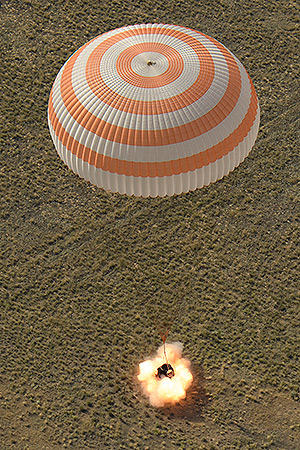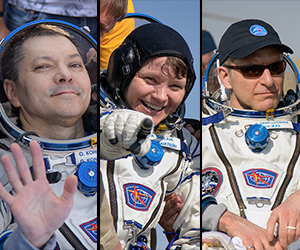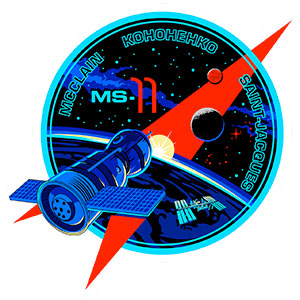June 24, 2019 — A Russian cosmonaut and astronauts from the United States and Canada have returned to Earth after spending more than 200 days on board the International Space Station.
Oleg Kononenko with the Russian space agency Roscosmos, Anne McClain of NASA and Canadian Space Agency astronaut David Saint-Jacques landed aboard Russia's Soyuz MS-11 spacecraft on Monday (June 24). Lowered by parachute and slowed by braking thrusters, the capsule touched down southeast of the town of Dzhezkazgan on the steppe of Kazakhstan at 10:47 p.m. EDT (0247 GMT or 8:47 a.m. local time on June 25).
The landing brought to a close the crew members' 204-day mission, which saw Kononenko, McClain and Saint-Jacques serve on the space station's 58th and 59th expedition crews. The trio arrived at the orbiting laboratory on Dec. 3, 2018.
"It takes about 3.5 hours between undocking from the space station to landing in Kazakhstan. It's been described as a roller coaster or a washing machine — dynamic, but also a precise and highly choreographed process," wrote McClain on Twitter about a week before coming home.
Kononenko, McClain and Saint-Jacques began their return to Earth at 7:25 p.m. EDT (2325 GMT), when their Soyuz MS-11 spacecraft separated from the space station's Poisk module on schedule. Their departure left behind cosmonaut Aleksey Ovchinin of Roscosmos and NASA astronauts Christina Koch and Nick Hague to begin Expedition 60.
A new three-person crew, including Aleksandr Skvortsov of Rocosmos, NASA astronaut Drew Morgan and Luca Parmitano of the European Space Agency, are scheduled to launch on Soyuz MS-13 to the space station on July 20.
On the ground in Kazakhstan, Kononenko, McClain and Saint-Jacques were met by Russian recovery forces, together with representatives and medical teams from NASA and the Canadian Space Agency. The three Soyuz MS-11 crewmates appeared to be in good spirits as they began adjusting to gravity while undergoing brief medical checks.
"It's really amazing how the human mind and body can adapt to new environments. How the once incredible can become so normal," wrote McClain on Twitter on Thursday (June 20), four days before her return to Earth. "I encourage all humans to do something out of your comfort zone that forces you to adapt. You'll be pleasantly surprised of your capabilities."
Over the past six months, the Expedition 58/59 crew members helped conduct hundreds of science experiments and oversaw the arrival and departure of several resupply ships. They were also in place to receive the first U.S. commercial crew spacecraft, SpaceX's Crew Dragon, on its uncrewed demo mission.
McClain and Saint-Jacques had some fun with the Crew Dragon's zero-g indicator, a Celestial Buddies' Planetary Pal Earth plush toy, which McClain dubbed "Little Earth." She and Saint-Jacques took turns photographing the doll around the space station and then sharing the images on Twitter to a great response.
McClain, Saint-Jacques and Kononenko also conducted spacewalks. McClain and Saint-Jacques ventured outside together to run power and network cables on what was McClain's second and Saint-Jacques first extravehicular activity (EVA).
Kononenko added two more spacewalks to his previous three, including an EVA to cut into and inspect the site of a pressure leak in the Soyuz MS-09 spacecraft.
"We tried to perform all of the tasks that were assigned to us," said Kononenko during a brief change of command ceremony held on Sunday (June 23) on board the space station. "All crew members were participating in our spacewalks, we all were performing a lot of experiments, a good amount of repair work has been performed as well, and we were really lucky to work together."
Expedition 58/59 was Kononenko's fourth stay on the International Space Station. He has now logged more than 737 days off Earth, ranking him sixth in the world for the most time accumulated in space.
McClain and Saint-Jacques completed their first space mission. Saint-Jacques now holds the record for the longest single spaceflight by a Canadian astronaut.
Departing their landing site, Kononenko, McClain and Saint-Jacques will be flown by Russian helicopter to the Kazakh town of Karaganda for a welcome ceremony before Kononenko departs for Star City, near Moscow, and McClain and Saint-Jacques board a NASA jet for the flight back to Johnson Space Center in Houston.
Soyuz MS-11 was the 57th Russian Soyuz spacecraft to fly to the International Space Station. It traveled a total of 86.4 million miles (139 million kilometers) over the course of 3,264 orbits of Earth. |
|

The Soyuz MS-11 spacecraft is seen as it lands in Kazakhstan with Expedition 59 crew members Oleg Kononenko, Anne McClain and David Saint-Jacques on Monday, June 24, 2019. (NASA/Bill Ingalls)

Oleg Kononenko, Anne McClain and David Saint-Jacques are seen shortly after landing on board Soyuz MS-11. (NASA/Bill Ingalls)

Soyuz MS-11 crew mission patch. (Roscosmos/spacepatches.nl) |
